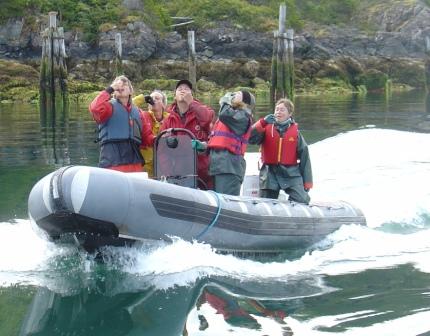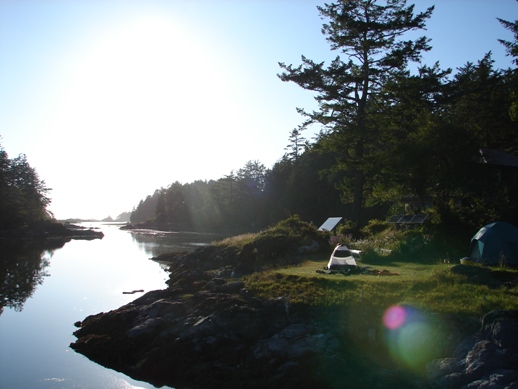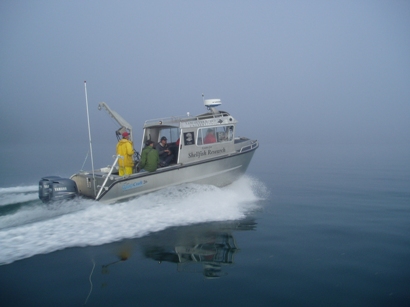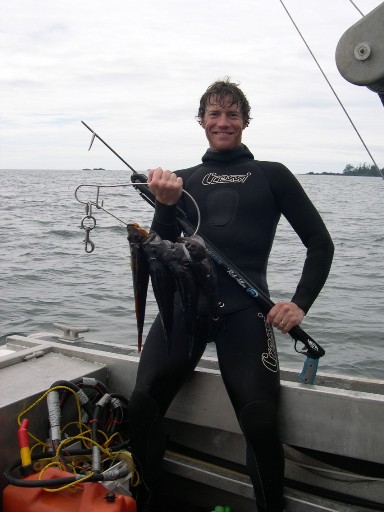The Olympia Expedition
Jul 31, 2008
In the early 1990s, a Canadian marine scientist named Brian Kingzett was engaged in an ecologist’s dream job. The province of British Columbia wanted to know how much of its Swiss-cheese coastline had the potential for shellfish aquaculture, and it hired Kingzett to find out. Kingzett was following a long line of explorers, including James Cook and George Vancouver, commissioned to mess about in boats along one of the wildest and most breathtaking coasts in North America. He surveyed the shore from Victoria all the way to the border with Alaska, recording the locations and characteristics of the beaches, surveying the species present, and snapping photographs of the most promising spots. Camping in the bush for days at a time, he came to know the coast like few others and saw some amazing things. One night he navigated by the luminescent seas as waves broke against reefs. He watched sea otters leave glowing trails like shooting stars as they dove. On a different trip, he anchored near remote hot springs every night.
One thing Kingzett saw stuck with him. He had pulled into a long inlet near Nootka Island at low tide and, pressed for time, was surveying the pocket beaches as quickly as possible. Most of the inlet was sheer rock plunging to depths of a hundred feet just a few yards offshore, but wherever a stream flowed out of the mountains, a cobbly delta had built up over the millennia, forming beautiful shellfish habitat. Kingzett would nose his boat onto each beach, leap ashore, jot down his notes, snap a photo, and zip on to the next. As soon as he set foot on the first beach in this particular inlet (name withheld to protect the innocent), he noticed something unusual. There were a smattering of mussels and Pacific oysters, plenty of barnacles and clams underneath, but portions of the beach were absolutely littered with small, round oysters—Olympias. Olys weren’t one of Kingzett’s specialties and he had no idea what their status was elsewhere on the Pacific coast, but it was unusual enough to see them in such abundance that he made a mental note of it. In his seven years of surveying the coasts, he found just a handful of beaches burgeoning with olys.
Fast forward ten years. Kingzett was at a shellfish conference and met Betsy Peabody, Executive Director of the Puget Sound Restoration Fund. He asked her what she did. She told him about her oly restoration efforts. He said that’s funny, ten years ago I came across acres of those little guys. Peabody was just a wee bit interested.
In July 2008, I accompanied a multidisciplinary team, guided by Kingzett and our skipper, Stephanie Richards, both of Vancouver Island University’s Centre for Shellfish Research, into the fjords of Vancouver Island, not far from Nootka Island. Our goal was to find these oly populations, if they still existed, and to learn what we could from them—to use these natural beds, which may have been around for millennia, as a kind of role model for the habitat enhancement efforts PSRF is leading in Puget Sound. Team members such as Joth Davis, lead scientist on PSRF’s native oyster enhancement projects; Brian Allen, PSRF staff ecologist; Mike Beck, Senior Scientist for The Nature Conservancy’s Global Marine Initiative, and Sarah Davies of Canada’s Department of Fisheries and Oceans, helped put the “multi” in multidisciplinary. Betsy Peabody supplied the discipline.

Imagine that somebody in the future stumbled upon one of the last cars in existence. It was a Ferrari, scattered in pieces, and wasn’t functioning, but a lot of the pieces seemed to be in pretty good shape. This future dweller wanted to put the thing back together, but he’d never seen a working car and didn’t even have a manual. How would he go about doing it? Well, he’d start tinkering, using his common sense, and if he was really handy, maybe he’d get it running and firing on a couple of cylinders. He’d roll across the land at five miles an hour and consider it a success, having no idea that there were missing pieces he’d never seen, and that a car is capable of much, much more.
That’s the situation facing those working to restore the Puget Sound ecosystem. The system still works, but decades of poor maintenance and occasional breakdowns have left it limping along. Few people can even remember that it used to run differently. But it is capable of doing much more for us.
If you wanted to restore a vintage Ferrari and you couldn’t find a manual, the first thing you’d do is to take a look at another Ferrari of the same model. When Brian Kingzett met Betsy Peabody, what he was basically telling her was, “Hey, when I was poking around those fjords, I came across a 308 GT in excellent condition.” So we went to check it out.
The ecosystem of Vancouver Island’s west coast is still firing on all cylinders. Its intertidal zone is a biological hotspot teeming with mussels, barnacles, oysters, clams, rock scallops, periwinkles, limpets, crabs, sea stars, sculpins, and seaweeds of all kinds. Black bears camp out on the beaches, rolling rocks to get at the gunnels beneath. Eagles loiter in the spruce tops and black crows scoop up clams and shatter them on the rocks. Offshore, the kelp beds are thick with rockfish and urchins. Gangs of sea otters cruise the lanes, hustling up pounds of clams, urchins, and crabs every day. They even excavate geoducks, leaving bomb craters in the sand.
One of the lynchpins holding all this together is the oyster beds. Like little rivets bolting the sea to the land, they are what makes the ecosystem one seamless whole. But would they still be there? As we boated for hours through the fjords aboard the MV Atrevida, a research vessel whose name means “audacious” and whose namesake was one of the ships Captain Alexandro Malaspina used to explore these very inlets in 1791, Kingzett worried about the oysters. It had been fourteen years, after all, since he’d last seen them.
Our first full day, we arrived too late to catch the low tide, so Kingzett steered the inflatable near one of the pocket beaches and we dangled our heads over the side, noses pressed against the glassy surface. Nothing but clams, mussels, barnacles, more clams. Then, suddenly, the surface dropped a foot and there they were: olys, olys, olys. The mother beds had survived. Soon, Joth Davis and Brian Allen were in the water, snorkeling with their favorite bivalve.
The next morning, we yanked ourselves awake early enough to catch the 7 a.m. low tide, concentrating our efforts at the head of the inlet, where an oly bed several acres wide spread in glorious profusion. We set to work taking an oyster census, keeping a watchful eye on the bears foraging a bit higher on the beach. We counted oysters, measured beds, and asked some questions. What were they setting on? Who was living with them? What were they eating? Who was eating them? Did they prefer intertidal or subtidal living? We wanted to know why these oysters had persisted here for so long and whether the same conditions might benefit Puget Sound’s olys.
A few important things we learned:
· Unlike Pacific oysters, olys are not reef builders. They form flat beds, little more than one oyster deep, on rocky substrate, with a rich layer of clams underneath.
· Although their Latin name, Ostrea conchaphila, means “shell-loving oyster,” they seemed to prefer setting on rock to setting on each other.
· Predation on the oysters—primarily by sea stars—was light, compared to Puget Sound. These olys were happiest low in the intertidal zone, where sea stars had to keep their visits brief.
· Perhaps most important, we learned that olys and humans can live well together. This was no pristine inlet. Logging was heavy on the upland slopes and had been for decades. According to Vancouver Island’s West Coast, a history of the area written by George Nicholson in 1962, “Acres of native oyster beds occur at the head of the inlet, from which thousands of sacks were once shipped to Vancouver and Seattle…. Now they are free to anyone who wishes to gather them.” Olys don’t need to be coddled or walled off to thrive. They have been and can continue to be an important source of food and habitat for a variety of creatures in the area, including Homo sapiens.
In addition to its array of quadrats, calipers, shellstrings, hobos, fyke traps, plankton pumps, and algae presses, our team used its sophisticated sensory apparatus to analyze several olys for qualities such as salinity, amino acid content, and yumminess. The samples proved to be high in all three categories. Thus encouraged, we performed the same analysis on a number of other species in the area. We dug clams. We shucked pacific oysters. We caught sole. We ate beach onion and pickleweed. Let it be noted that the high tides gave us some down time.
When it came to procuring seafood, the only animal in the vicinity that could give the sea otters a run for their money was Brian Allen. With wetsuit and speargun, Allen plunged into the kelp beds offshore and emerged with a string of rockfish. He cut a six-foot strand of kelp so that I could make miso soup with the fronds and Betsy Peabody could make pickles with the stalk. He popped limpets off their rocky purchases and grilled them in their inverted shells for the ultimate beach appetizer.
All this foraging gave us a profound sense of the abundance of the area, which is perhaps the defining characteristic of the Pacific Northwest coast. We love the Pacific Northwest for its drama and its stark, misty beauty, but we especially love it because for ten thousand years it has been a really, really good place for people to live. Evidence of that was all around us on Nootka Island. At Friendly Cove, we spoke with the descendents of the Nuu-chah-nulth tribe that welcomed Captain James Cook to these shores in 1778. From our base in the Nuchatlitz Islands, we could look down a sinuous tidal canal and see a line of boulders placed as a fish trap by that same tribe centuries ago. And on one particularly stunning pocket beach of olys, I worked around a mysterious semicircle of rock for hours before Brian Kingzett pointed out that this, too, had been a fish trap. Fish came in on the high tide, then got trapped as the receding waters trickled out between the rocks. All you had to do was scoop up the stragglers. Easy livin’.
That pocket beach proved to be the prize find of the trip. We didn’t discover it until our last day, when we fanned out to survey new spots. Mike Beck and I had been dropped off to check this particular beach, and it took us all of about three seconds to see that this one was special. The red, green, and black cobble was gilded with a nearly continuous sheen of white-gold olys. We excitedly snapped photos and tossed quadrats. Densities exceeded 600 oysters per square meter—a concentration unheard of in Puget Sound—and gave a hint of how beautiful and productive an oly bed can be. “Look at this,” Mike said. “These oysters are the dominant life form on this beach. They are the structure.” If all you’ve ever seen of olys are the patchy survivors in Puget Sound, and you’ve wondered how such critters could have fueled a vast industry from San Francisco to Vancouver for decades, one look at this bed would make it all clear. We had only the briefest of chances to learn about this Ferrari of an oyster bed that goes by the humble name of Pocket Beach #3, so a return trip is vital for future restoration efforts in Puget Sound and elsewhere.
As the Atrevida pulled away from shore, Mike Beck posed a question to us—one that has yet to be answered. “From a conservation perspective,” he asked, “what would you do about something like this? It probably isn’t the only beach like this on Vancouver Island, but say there’s three or four, and maybe another twenty like the one at the head of the inlet. And that’s it. In the world. What would you do?”
« PREVIOUS: Spring Oysters
» NEXT: Coming Soon to a Festival Near You



 Recent Posts
Recent Posts
